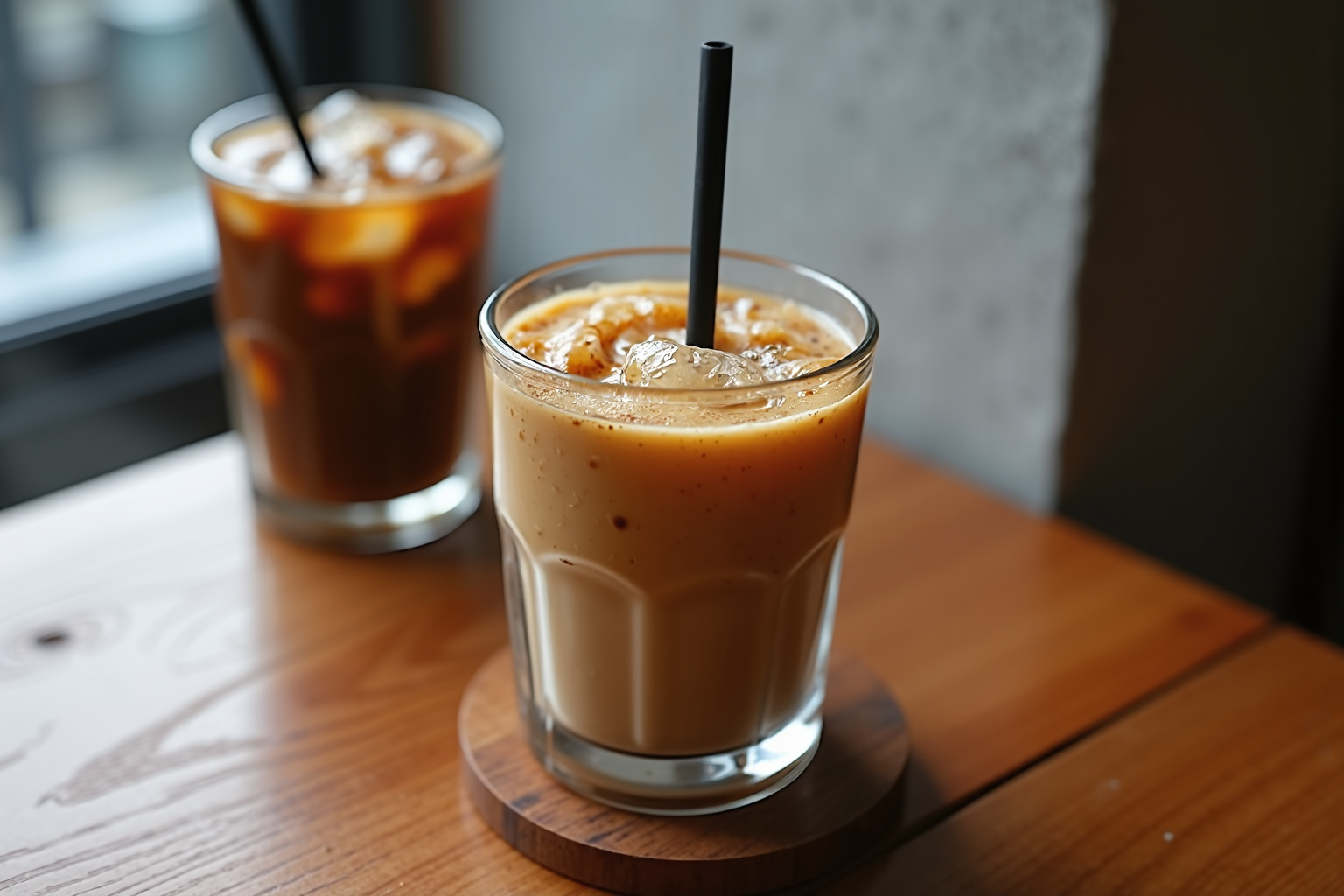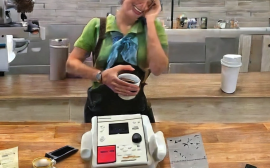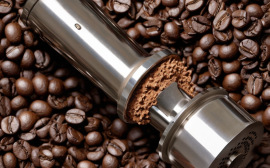The Rise of Japanese Iced Coffee: A New Era of Cool
The premium coffee scene is experiencing a seismic shift, with Japanese iced coffee emerging as the undisputed star. This meticulously crafted beverage transcends the conventional notion of simply chilling coffee; it represents a sophisticated approach to brewing that prioritizes precision, nuance, and an elevated sensory experience. Japanese iced coffee employs specialized techniques like flash brewing to unlock the full potential of carefully selected beans, resulting in a vibrant and complex cup that captures the essence of Japanese coffee culture. From the minimalist cafes of Tokyo to the bustling coffee shops of New York, London, and Melbourne, this trend is captivating coffee aficionados and redefining the iced coffee landscape. The meticulous nature of Japanese iced coffee preparation speaks to a larger global trend towards premiumization in the coffee industry. Consumers are increasingly seeking unique and high-quality coffee experiences, and they are willing to pay a premium for them. A recent survey by the Specialty Coffee Association revealed that 63% of coffee drinkers are willing to spend more for a premium cup, highlighting the growing demand for specialized brewing methods and high-quality beans. Japanese iced coffee caters perfectly to this evolving consumer preference, offering a distinct and refined taste profile that sets it apart from traditional iced coffee. Flash brewing, the core technique behind this trend, involves pouring hot water over coffee grounds directly onto ice. This rapid chilling process preserves delicate aromas and minimizes bitterness, resulting in a remarkably clean, sweet, and nuanced brew. The technique itself is visually captivating, adding a theatrical element to the brewing process that enhances the overall cafe experience. This emphasis on visual appeal and meticulous preparation aligns perfectly with the Japanese aesthetic of precision and artistry, further contributing to the premium perception of Japanese iced coffee. Moreover, the use of specialized equipment like the Hario V60, Kalita Wave, and dedicated ice brewing devices adds another layer of sophistication and control to the process. These brewers allow baristas to fine-tune the brewing parameters, ensuring optimal extraction and a perfectly balanced cup. The growing popularity of Japanese iced coffee also presents a unique opportunity for cafe management. By incorporating this premium beverage into their menus, cafes can cater to the growing demand for high-quality coffee experiences and command higher price points. This, in turn, can lead to increased profit margins and a stronger brand identity. The key to successful implementation lies in barista training, ensuring consistent quality and an efficient workflow. By educating consumers about the unique brewing methods and the superior quality of the beans used, cafes can further justify the premium price and cultivate a loyal customer base.
Flash Brewing: The Science of Flavor
Flash brewing, a cornerstone of Japanese iced coffee preparation, represents a significant departure from traditional iced coffee methods. It involves the dynamic process of pouring hot water over coffee grounds directly onto ice, creating a rapid temperature change that locks in flavor and aroma. This immediate chilling halts the extraction process at its peak, minimizing the development of bitterness and preserving the delicate nuances of the coffee beans. The result is a remarkably clean, bright, and sweeter cup that showcases the coffee’s inherent characteristics, a stark contrast to the often-dull and oxidized profiles of conventionally chilled coffee. The difference is particularly noticeable with lighter roasts and single-origin coffees where the subtle flavor notes truly shine through. Traditional iced coffee, often brewed hot and then chilled, suffers from prolonged exposure to heat, leading to oxidation and a muted flavor profile. This extended brewing time extracts more bitter compounds, masking the coffee’s true potential. Flash brewing, with its precision and control, delivers a superior sensory experience, aligning perfectly with the growing consumer demand for premium coffee. In the context of cafe management, flash brewing offers a compelling point of differentiation. The visual appeal of the brewing process itself can be a draw for customers, transforming a simple beverage order into an engaging experience. This method is particularly well-suited for showcasing high-quality, single-origin beans, allowing cafes to highlight their commitment to sourcing and craftsmanship. Furthermore, the use of specialized equipment like the Hario V60, Kalita Wave, or dedicated ice brewers not only enhances precision but also adds to the theatrical element of the preparation. The perceived value of this meticulous process justifies a premium price point, contributing to increased profit margins. By emphasizing the quality of their beans and the unique brewing method, cafes can attract discerning coffee enthusiasts willing to pay for an elevated coffee experience. This focus on quality and innovation resonates strongly within the current coffee trends, positioning cafes at the forefront of the specialty coffee movement. The rise in popularity of Japanese iced coffee, fueled by social media and a growing appreciation for meticulous craftsmanship, presents a valuable opportunity for cafes to cater to a sophisticated consumer base. By investing in proper training and equipment, cafes can ensure consistent quality and efficient workflow, maximizing the profit potential of this innovative brewing method. This precise temperature control, facilitated by careful management of the ice-to-water ratio, allows baristas to fine-tune the final brew, ensuring optimal extraction and a balanced flavor profile, further enhancing the premium coffee experience.
Precision and Control: Mastering the Art
In the realm of flash brewing, temperature control reigns supreme, impacting the final cup’s delicate balance between aroma, body, and flavor. Achieving this mastery involves a precise interplay between water temperature and the quantity of ice used. The ice-to-water ratio isn’t merely a matter of chilling; it directly dictates the final brewing temperature and the resulting coffee’s strength. Too little ice, and the brew becomes overly diluted and lacks the desired intensity. Conversely, excessive ice can lead to under-extraction, resulting in a weak and underdeveloped flavor profile. Finding the optimal balance is crucial for unlocking the coffee’s full potential. This pursuit of precision has led to the development of specialized equipment designed specifically for flash brewing. Devices like the Hario V60 and Kalita Wave, renowned for their pour-over capabilities, offer a high degree of control over the brewing process. Their unique designs facilitate even water distribution over the coffee grounds, ensuring consistent extraction and minimizing channeling. Dedicated ice brewers, with their built-in ice chambers, further streamline the process, allowing for immediate chilling and preserving the coffee’s delicate nuances. However, simply having the right equipment isn’t enough; mastering the technique requires a deep understanding of the variables at play. Digital scales ensure precise measurements of both coffee and water, contributing to consistent results. Thermometers provide real-time temperature readings, allowing baristas to fine-tune their approach and compensate for ambient temperature fluctuations. This data-driven approach empowers cafes to replicate their signature brews consistently, delivering a predictable and high-quality experience to their customers. The growing popularity of Japanese iced coffee within premium cafes reflects a broader trend in consumer behavior: a willingness to pay a premium for quality and craftsmanship. Flash brewing, with its emphasis on precision and meticulous execution, aligns perfectly with this trend. By showcasing the specialized equipment, highlighting the careful temperature control, and emphasizing the superior flavor profile, cafes can effectively communicate the value proposition of Japanese iced coffee. This transparency not only justifies a higher price point but also elevates the entire coffee experience, transforming it from a simple beverage into a carefully curated ritual. From a cafe management perspective, incorporating flash brewing into the menu presents both opportunities and challenges. The initial investment in specialized equipment and barista training can be significant. However, the potential for increased profit margins, driven by higher customer demand and premium pricing, makes it a compelling proposition. Moreover, offering Japanese iced coffee allows cafes to differentiate themselves from competitors, attracting a discerning clientele seeking unique and high-quality coffee experiences. In a competitive market, this distinctiveness can be a key driver of success, establishing a cafe as a destination for coffee connoisseurs.
The Premium Factor: Consumer Perception and Pricing
The specialty coffee market has witnessed a notable shift in consumer behavior, with an increasing willingness to pay a premium for unique and high-quality coffee experiences. This trend aligns perfectly with the rise of Japanese iced coffee, which, through meticulous preparation methods like flash brewing, offers a superior flavor profile that justifies a higher price point. The perceived value of this meticulously crafted beverage extends beyond the immediate sensory experience, encompassing the artistry, precision, and cultural significance associated with Japanese coffee culture. Cafes can effectively leverage this consumer perception by strategically highlighting the unique brewing methods employed, emphasizing the quality and origin of their coffee beans, and showcasing the enhanced flavor experience that flash brewing provides. For instance, describing the distinct characteristics of a single-origin Ethiopian Yirgacheffe bean brewed using the flash brewing method and highlighting its bright acidity and floral aromas can resonate with discerning coffee enthusiasts. Educating consumers about the artistry involved, the specific equipment used (like the Hario V60 or Kalita Wave), and the impact of temperature control on the final cup can further enhance their appreciation and willingness to invest in a premium experience. This educational approach transforms the transaction from a simple purchase into an exploration of coffee craftsmanship. The visual aspect also plays a crucial role; showcasing the flash brewing process itself, with its dramatic pouring of hot water over ice, can create a captivating experience that adds to the perceived value. Furthermore, offering tasting flights or comparative tastings between traditionally brewed iced coffee and flash-brewed coffee can allow consumers to directly experience the difference in flavor clarity and complexity, reinforcing the premium positioning of Japanese iced coffee. This direct comparison can effectively demonstrate the value proposition of the unique brewing method. Highlighting the origin and ethical sourcing of the beans used further elevates the perceived value, appealing to consumers who prioritize sustainability and fair trade practices. By presenting Japanese iced coffee as a unique and elevated coffee experience, cafes can attract a discerning clientele willing to pay for quality and craftsmanship, ultimately increasing profit margins. In a competitive market, this distinct offering can be a key differentiator, attracting and retaining a loyal customer base that values both quality and experience. The premium pricing strategy should be carefully considered in relation to the target market and local competition, ensuring it aligns with the overall brand positioning and cafe ambiance. Ultimately, the success of implementing Japanese iced coffee hinges on providing a holistic experience that justifies the premium price, encompassing the quality of the coffee, the brewing method, the presentation, and the educational narrative shared with the consumer. This holistic approach elevates the beverage beyond a simple refreshment and transforms it into a curated coffee experience.
Cafe Implementation: A Profitable Brew
Implementing Japanese iced coffee, specifically through flash brewing, presents a significant opportunity for cafes to enhance their offerings and boost profitability. While the initial investment in specialized equipment like the Hario V60, Kalita Wave, or dedicated ice brewers might seem daunting, the potential return on investment is substantial. The premium price point that Japanese iced coffee commands, often 20-30% higher than traditional iced coffee, coupled with increasing consumer demand for unique and high-quality coffee experiences, can lead to a significant increase in profit margins. Moreover, the visual appeal of the flash brewing process itself can serve as a draw for customers, creating a sense of theater and reinforcing the cafe’s commitment to quality. Successful cafe implementation also hinges on a well-defined workflow. Baristas need comprehensive training not only in the technical aspects of flash brewing, such as precise temperature control and ice-to-water ratios, but also in communicating the nuances of the brewing process and the unique flavor profiles it produces to customers. This education component is crucial for justifying the higher price point and building a loyal customer base that appreciates the care and expertise that goes into each cup. Consistency is key, so standard operating procedures must be established to ensure that every Japanese iced coffee served meets the cafe’s quality standards. The selection of high-quality coffee beans is paramount for success with flash brewing. The method’s ability to highlight delicate flavors means that using lower-quality beans can result in a less-than-desirable outcome. Cafes should consider sourcing single-origin beans with distinct characteristics that are enhanced by the flash brewing method. For example, a bright, citrusy Ethiopian Yirgacheffe will exhibit a more pronounced acidity and floral aroma when brewed over ice, offering a markedly different experience from the same bean brewed hot. Furthermore, cafes should actively promote the unique characteristics of their Japanese iced coffee, emphasizing the precision and care involved in its preparation. Marketing efforts can highlight the flash brewing process, the specialized equipment used, and the superior flavor profile achieved through this method. Visual aids, such as videos showcasing the brewing process, can be used to engage customers and educate them about the benefits of flash brewing. By positioning Japanese iced coffee as a premium offering, cafes can attract a discerning clientele willing to pay for an exceptional coffee experience. Beyond the direct revenue generated from sales, offering Japanese iced coffee can also enhance a cafe’s brand image, positioning it as a leader in the specialty coffee scene. This can attract new customers, increase overall foot traffic, and foster a sense of loyalty among existing patrons. In the competitive cafe market, offering unique and high-quality beverages like Japanese iced coffee is a powerful way to differentiate a business and establish a strong brand identity. The meticulous nature of flash brewing, combined with the focus on quality and flavor, aligns with the increasing demand for premium coffee experiences, making it a worthwhile investment for cafes looking to thrive in the current coffee landscape.



